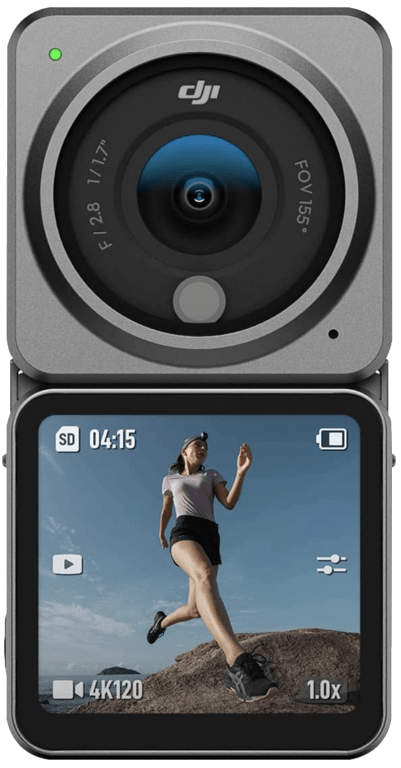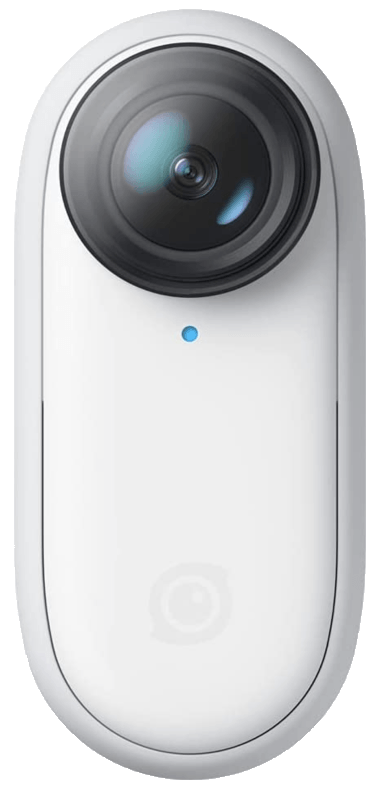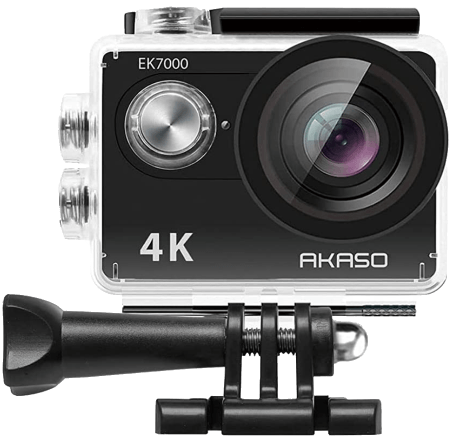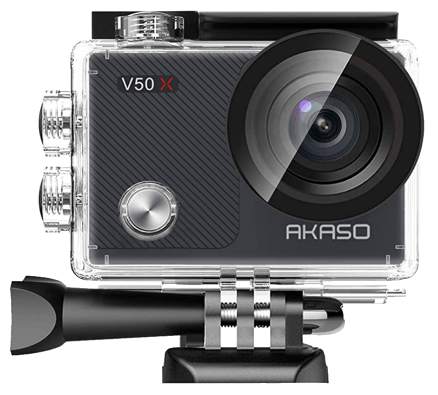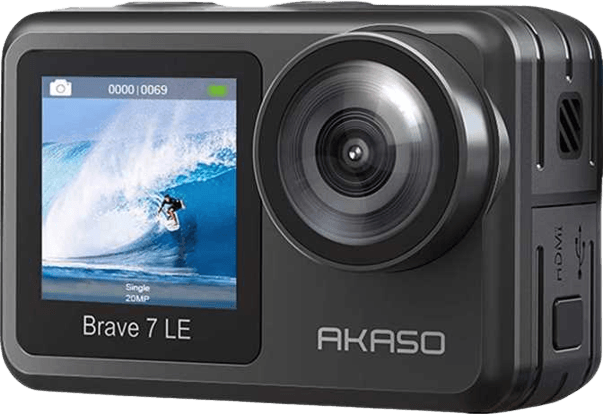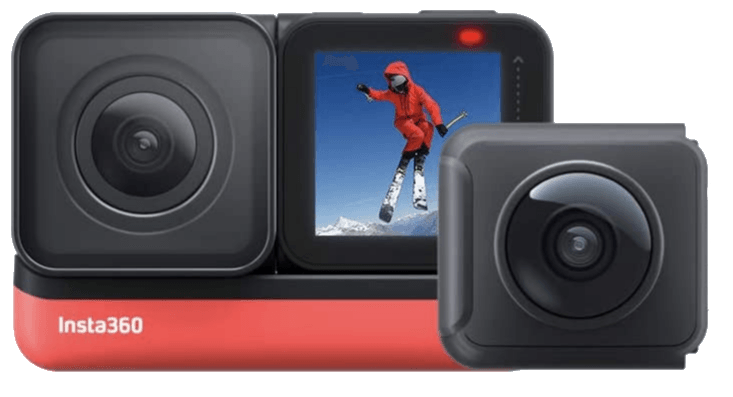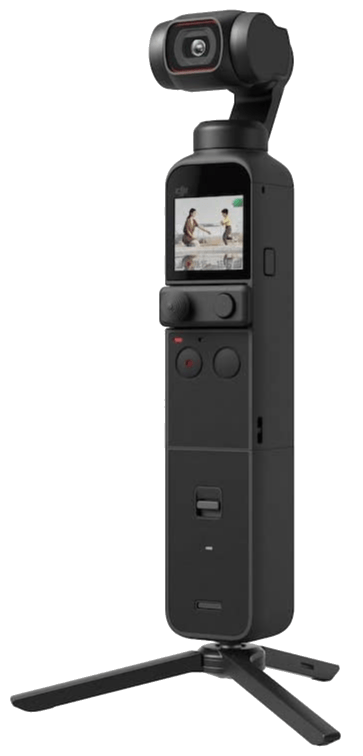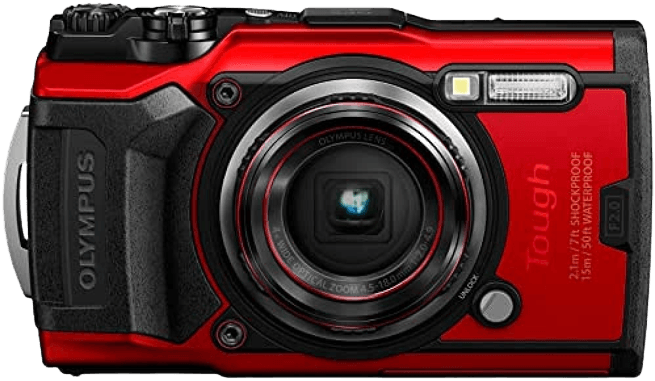The range of action cameras is now quite dizzying. And some have redefined the action camera. But our top pick for an alternative action camera is the DJI Action 2. It has a unique modular design, 8x slow motion at full HD, and great image stabilization. [Note: ExpertPhotography is supported by readers. Product links on ExpertPhotography are referral links. If you use one of these and buy something, we make a little bit of money. Need more info? See how it all works here.]
What Is the Best GoPro Alternative?
We’ve put together a great collection of alternative action cameras. Before we look at why we like them in detail, here’s a summary.
8 Best GoPro Alternatives
And now, starting with our overall top pick, here are the in-depth looks at each camera. None of the cameras in this review is a poor performer. And you can find a good GoPro alternative with solid features that won’t break the bank! The DJI Action 2 took an innovative approach to create an action cam. And the results are interesting and largely successful. It is definitely head-to-head with GoPro in the battle for a premium action camera. It is modular. And the main camera is a small cube. DJI makes the most of this modular capability. You can add a battery module for extended power. Or you can add a front screen module for selfies or talking to the camera. Then you connect these to the camera magnetically. Magnets are also the key to a range of mounting options. A lanyard allows you to clip the camera to your clothes. And there are headbands, ball joints, and mount adapters. Perhaps only the Insta360 Go 2 is as flexible. The DJI Action 2 does not compromise image quality. You can get amazing slow-motion shots in 4K at up to 120 fps. The image stabilization is consistently impressive. And the horizon lock keeps everything steady. Choosing between this and the GoPro Hero11 Black depends on personal preference. The Insta360 GO 2 looks nothing like a GoPro. There is no screen and no 4K. So how can it be more expensive than the cheapest GoPro camera? Well, this camera actually makes a GoPro look chunky and awkward to carry around. The tiny camera comes with a charging case. It’s sleek and fits easily in your pocket. And it has two built-in legs so it can lean back and film on any flat surface. It also contains a small status screen and remote control buttons. So you can control the camera from up to 33 ft (10 m) away. As if that wasn’t enough, the case has a standard tripod mount. This means you can mount it in various ways. And a pivot mount with a reusable sticky pad sticks the camera to pretty much any flat surface. All in all, the rapid versatility sets the Go 2 apart from all the cameras. But you have to weigh the lack of 4K video and consider how important that is for you. The image quality is good. Image stabilization is impressive. And the horizon lock means your viewers won’t get vertigo from watching your footage. It’s cool to watch. This is one of the most versatile and well-thought-out GoPro alternatives around. The Akaso EK7000 is a great GoPro alternative for someone who wants to try one out without committing large amounts of money. Or perhaps you want to film something, and there is a chance you might lose the camera. Then the Akaso would be perfect. It has a 170-degree viewing angle, films up to 4K at 25 fps, and has a maximum resolution of 12 MP for still photos. For 16 MP and image stabilization, you must upgrade to the EK7000 Pro. But it crops the viewing angle a little. Video quality is what you hope for in a cheap GoPro alternative. The EK7000 is a cheap action camera you can use underwater. And it captures reasonably good video and still photos. If a low price is your main consideration, it is a passable intro to action camera photography. The Akaso V50X improves on several aspects of the EK7000. The touchscreen is more responsive. The field of view adjusts to 70, 110, 140, and 170 degrees. Image stabilization is also significantly better. The video quality on this alternative is less punchy than its more famous inspiration. GoPro video tends to be quite contrasty, giving it a recognizable GoPro “look.” The Akaso is slightly flatter. This might be more to your taste. But it does mean there are places where the video is less likely to blow out in the highlights. Slow-motion footage is pretty impressive at this price point. Low-light photography (which is always a problem with small sensors) is not as good here as with the HERO8. (You can read our GoPro HERO8 review.) The latter has a low-light mode which reduces noise and increases sharpness. The V50X can’t match this, but it is significantly cheaper. This is still a good choice if budget is your main factor. If you can stretch it, it’s worth the extra cash compared to the EK7000. It outperforms the cheaper stablemate across all important factors. The last and most expensive Akaso GoPro alternative is the Brave 7 LE. This version has some notable improvements over the V50X. The most obvious is this has a front screen. It makes a big difference for action camera users. Image stabilization performance is better. Although it still has the crop factor. There is some waterproofing built into the main camera. It won’t mind getting splashed, and you can submerge it in water. But remember that depth ratings are for static situations. If you dive into a 10-foot pool, your camera needs more than a 10-foot rating. As with all the Akaso cameras in this review, the Brave 7 LE has an impressive number of accessories. It has a waterproof housing. There are lots of different mounts and a dual battery charger—with two batteries! And it also has a standard tripod mount on the body. Image quality leans more toward the GoPro look than the other Akaso cameras. It’s not quite as punchy, but blacks are much more suppressed. Detail retention in shadows is still good. And there’s no significant problem with blown-out highlights. In a side-by-side test with a GoPro HERO9, the GoPro outperforms the Akaso on most metrics. But they are in very different price brackets. The 7 LE is perhaps the one Akaso camera we recommend without emphasizing “for the money” at the end. This makes it one of the best GoPro alternatives in this review. The Insta360 ONE really is a fresh approach as a GoPro alternative. It’s also a modular camera. There’s the ONE RS Core, a cube that is the heart of the camera, with a screen on one side. You can add the 4K boost lens. Or you can choose the 5.7K 360 lens for 360-degree shooting. Or there’s the 5.3K 1-inch lens made by Leica. This has the largest sensor of any action camera. All these modules lock together rather cleverly. This gives unmatched flexibility in any single camera on our list. Plus there are many Insta360 ONE accessories. You can buy the MantisPod (tripod) or an extra battery base. Every camera so far has fallen short of GoPro’s highly-regarded image stabilization (IS) system. With the Insta360, the maximum stabilization is arguably as good as the GoPro HERO10 Black. The latter doesn’t have the same flexibility, though. It’s high praise that the Insta360 ONE is often compared to the HERO10. Its 4K edition is significantly cheaper than the GoPro. And for a little more than the GoPro, you get the 360-degree lens for amazing video footage. With the “invisible selfie stick,” the camera appears to hover above your head or travel alongside you. And you can reframe the footage after shooting to give some striking effects. I think that video quality, slow-motion quality, and some of the time-lapse capabilities are better on the HERO10. But the Insta360 ONE is close enough to make it very tempting as a high-quality alternative to a GoPro. As you can see from the above specs, the DJI Pocket 2 has the most-impressive camera specs. But it doesn’t have waterproofing. Is it even an action camera? Well, I think it depends on what you want. If you’re kayaking or dirt biking, probably not. But many GoPro alternatives get used because of their compact size and image stabilization. And the DJI Pocket 2 can be a good choice. First, stabilization causes no loss of image quality. This is because it’s mechanical—via a gimbal—not electronic. Second, it has a big sensor. And the quality of the video and stills captured is high. Slow-motion footage is shot at 240 fps, which is better than anything else we’ve seen so far. And combining pre-timed panning with time-lapse video produces some stunning results. Creators looking for a simple walk-and-talk camera will find the Pocket 2 an excellent choice. The reliable stabilization and video quality are added bonuses. The Olympus Tough TG-6 is a different beast than all the other GoPro alternatives. I include it here for those who might want an action camera, mainly for its waterproof credentials. (Even though the underwater housing or the TG-6 is sold separately.) The TG-6 is mainly an underwater camera. It’s designed to be tough out of the water. But it’s optimized for use in the water. The quality of video and still photos from the Olympus is as you would expect from a major manufacturer. Underwater photographers particularly like the macro and microscope modes. And the quality of the pictures is amazing. Olympus has been making compact cameras since the 35mm 1/2 frame Pen in 1959. So they know a thing or two about it. The Tough TG-6 is a refinement of the highly rated TG-5. It is easier to use, with quicker access to macro and microscope photos. This camera fits neatly between compact action cameras and bigger DSLRs with underwater rigs. If underwater is your thing, read out article on waterproof cameras.
What Should You Look for in an Action Camera?
The best GoPro alternatives will perform strongly in all even of these areas:
1. Ruggedness
Action cameras have to withstand treatment that would destroy a normal camera. So your action camera should laugh at The Four Horsemen of the DSLR Apocalypse—dust, grit, shock, and weather. The best GoPro alternatives have weatherproof, dust-resistant, and shock-resistant bodies. But in many cases, this does still leave the lens vulnerable. This is especially true for wide-angle lenses that often protrude from the camera body.
2. Waterproofing
Action cameras vary in their resistance to water. Some have a watertight body for limited proofing and need external housing to go deeper. Be sure to check the depth ratings for your chosen action camera.
3. Image Stabilization
There’s a point where shaky camera work ceases to emphasize the action and starts to become tiresome. Electronic image stabilization (IS) is important when choosing a GoPro alternative. Unless you want a Cinéma vérité feel to your bungee jump, you need in-camera IS. The best GoPro alternatives will also offer some form of horizon leveling.
4. Viewing Angle
One key aspect of that GoPro “look” is the wide viewing angle. A wide-angle lens lets you capture all the action without worrying about framing the shot. After all, your attention is likely to be elsewhere. A feature to look out for is adjustable “digital” lenses. Basically, the digital cropping of an image allows a tighter composition. This is possible nowadays because cameras record in at least 4K.
5. Image Resolution
Action cameras need to be good at both video and still photography. But perhaps video is more important. Many let you capture high-resolution stills from video footage. When choosing a GoPro alternative, you shouldn’t compromise image quality.
6. Sound
Flexibility in recording sound is important. My recent review of microphone attachments for action cameras talks you through the options for improving the sound of your video. Poor sound is more likely to ruin your video than anything else. It’s worth it to have external microphone connectivity on your GoPro alternative.
7. Other Features
There are so many features to look out for. Keep your eyes open for the following:
Front screen Face or smile recognition Time-lapse Remote control or voice control Good battery life
You can check out our Total Time-Lapse course to get amazing time-lapse videos from any of these action cameras!
Conclusion: Best GoPro Alternatives
Competition with action cameras is good news for the consumer. It has led to some exciting innovations. At the top end of the scale, the quality and features of the best GoPro alternatives are quite something. And less sophisticated cameras are competitive at the cheaper end of the price scale. If you’re not completely sure about an action camera or have a tight budget, then you can’t go too wrong with the Akaso EK7000 or EK7000 Pro. If you’re looking for a top-quality alternative, the DJI Action 2 is the best choice. It has an impressive range of features, performs at an excellent level, and has flexibility that sets it apart.
